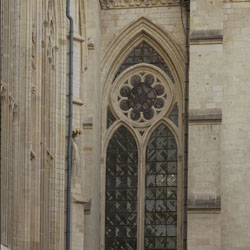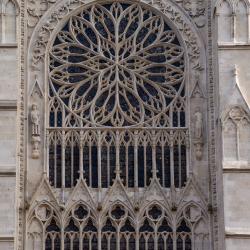South transept facade, portal of St. Honoratus
We are looking down a broad nineteenth-century street on the axis of the south transept façade: on the Middle Ages this street was crooked and much narrower. The churches of S-Nicolas-au-Cloître and S-Martin-aux-Jumeaux, demolished in the early nineteenth century were just to our right.
The south transept façade is composed of three vertical segments defined by four buttresses. In the central segment a sumptuously-decorated portal occupies the lowest level, half way up a passageway with gabled panels marks the level of the triforium and at the top, a great rose window. In the gable prophets stand between the little decorative buttresses and a bishop in the middle. The central vessel is flanked with aisles, each with a great tracery window.
Note the asymmetry of the composition. The aisle windows do not match, the one to the right with three small oculi belongs to the type we have associated with the work of Thomas de Cormont (1230-40s), while that to the left is the work of Robert de Luzarches soon after 1220. The little drip moldings on the front surfaces of the buttresses do not match: those on the left are pitched more steeply than those on the right. In the middle level the aisle on the left has a lean-to roof terminated in a masonry wall with a little rose window. On the right the aisle is roofed with a little wooden pyramidal structure like a witch's hat. The passage across the central segment is not quite level (it rises to the right). And any amateur of Gothic can spot the sharp difference between the "classic" tracery in the western aisle window and the flickering forms of Flamboyant in the rose. Interestingly, the great upper rose is surrounded by sculptured images representing a Wheel of Fortune: little figures ascend on the left and are thrown off on the right.
Construction Sequence
These eccentric features result from an extended and troubled construction sequence.
1. The lowest horizontal segment of the wall belongs to the earliest work by Robert of Luzarches soon after 1220.
2. The left (west) aisle bay with its window and buttress was done late 1220s by Robert and Thomas de Cormont
3. The central segment and right (east) aisle were done under Thomas 1230-40s: there is a suture in the masonry along the right side of the buttress dividing phases 2 and 3. Thomas brought the left (west) buttress almost to the top and the right (east) buttress to the clerestory sill. The central part of the upper facade was to be filled with glass and tracery framed by a floral band like the transept of Notre-Dame of Paris
4. In the 1250s and 1260s Renaud de Cormont completed the main buttresses, built the openwork flyers and installed the vaults. Concerned about the stability of the facade he added an additional strip of masonry inserted inside the floral band. He probably installed the first rose window
5. Around 1500 the tracery of the great central rose began to pop out and it was replaced with the existing Flamboyant rose, probably the work of Pierre Tarisel.

